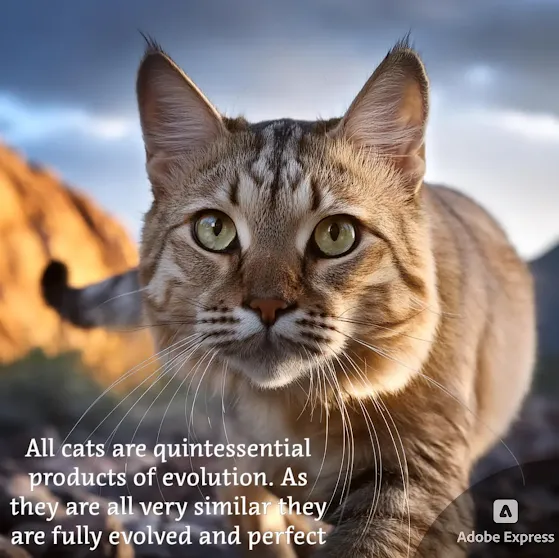 |
| Cats are perfectly evolved. Image: MikeB |
Perfection
Natural selection summarised
Here's a summary of natural selection incorporating genetic variation:
Variation: This is the foundation of natural selection. Individuals within a population have variations in their traits. These variations can arise from two main sources:
- Genetic mutations: Changes in the genetic material (DNA) can introduce new traits or alter existing ones.
- Sexual reproduction: The shuffling of genes during sexual reproduction creates new combinations of traits in offspring, even without mutations.
Inheritance: These variations, whether caused by mutations or sexual reproduction, can be passed on from parents to offspring if they occur in the organism's reproductive cells (eggs or sperm).
Competition: Organisms produce more offspring than the environment can support, leading to competition for resources like food, water, and shelter.
Selection: Individuals with traits better suited to the environment are more likely to survive and reproduce. These beneficial traits could be anything that helps them avoid predators, find food more efficiently, or resist disease.
Over Time: Over many generations, as beneficial traits are passed on more frequently, the population gradually changes. Individuals with these traits become more common, and the population becomes better adapted to its environment. This is how evolution occurs.
So, genetic mutations provide the raw material for variation, and natural selection acts on that variation, favouring traits that enhance survival and reproduction.
The evolution of the cat
The cat family's story stretches back millions of years, with twists and turns throughout:
- Ancient Beginnings (10-15 million years ago): The cat family (Felidae) arose in Asia, with a panther-like ancestor.
- Diversification (6-10 million years ago): DNA evidence suggests major branching within the Felidae family. Big cats like lions and tigers diverged from smaller cat lineages.
- Global Adventures (9 million years ago onwards): Land bridges allowed cats to migrate across continents. Cats reached North America and even migrated back to Asia at times.
- Ancestral Cats (around 10,000 years ago): The African wildcat (Felis silvestris lybica) is believed to be the ancestor of our domestic cats. These wildcats were drawn to human settlements by the abundance of rodents.
- The Domestication Dance (around 10,000 years ago): A gradual process likely unfolded. Early humans and wildcats may have tolerated, or even benefited from, each other's presence. Over time, selection may have favored cats with traits that made them more comfortable around people.
- From Partners to Pets: The exact timeline is fuzzy, but archaeological evidence suggests a close relationship between humans and cats by around 9,500 years ago. Cats transitioned from tolerated mousers to cherished companions.
This is a simplified version, but it captures the key points of the cat's evolutionary journey. From a common ancestor in Asia to our purring house cats, it's a story of adaptation, migration, and eventually, a unique partnership with humans.



No comments:
Post a Comment
Your comments are always welcome.